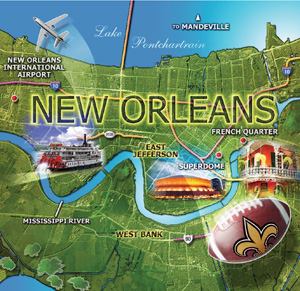The second-highest concentration of units is on the West Bank, a submarket located on the opposite side of the Mississippi River from downtown New Orleans. This area, which offers direct access to downtown New Orleans and the French Quarter, largely escaped the wrath of Hurricane Katrina. As a result, the population has exploded and demand for multifamily units far outpaces the supply, due mainly to a moratorium on apartment units that has been in place for the past three years. Investors feel as if they have a franchise of sorts when acquiring property in the area, as significant new construction is unlikely. Although sufficient land is available on the West Bank, the moratorium enjoys broad support among residents and the parish administration.
As in the other submarkets mentioned, the West Bank has occupancy levels in the 95 percent-plus range, with rental rates running in the low $.90 to $1.15 per square foot range. Recent sales in the area include the 288-unit Carlyle Apartments, the 380-unit West Chase Apartments, and the 307-unit New Orleans Towers.
With limited potential to build additional garden development on the Southshore, developers have looked north, over the 24-mile wide Lake Pontchartrain, to the Northshore. The area boasts the highest income levels in the state and hosted 60 percent of the state’s single-family construction in 2006. The majority of the area had minimal storm damage and, as a result, residents and retailers have flocked to the area. However, the Northshore welcome mat has not been rolled out to would-be apartment developers.
NIMBYism is alive and well in this area, with only one multifamily property under construction at this time. That project is the Chenier Apartments, a 288-unit, mixed-use luxury garden development in Mandeville, La., being developed by the Park Cos. of Metairie, La. Currently, the area has 2,800 units with 98 percent occupancy and rents in the $.95 to $1.30 per square foot range. Sales in the area have included three recently developed properties: the Villa du Lac (234 units) for $99,000 per unit; Botanica Apartments (228 units) for $118,000 per unit; and The Park @ Covington (264 units) for $93,000 per unit. What’s more, Chevron has announced plans to vacate its downtown New Orleans location and relocate to the Northshore, a move that will continue to add to the population and appeal of this submarket.
The highest rents in metro New Orleans, however, are still in the Central Business District/Historic Center/Mid City submarket. This area is in the “hub” of everything people associate with New Orleans: the river, historic St. Charles Avenue, and the French Quarter. The inventory in this area numbers 2,100 units—almost exclusively loft-style developments that were converted from turn-of-the-century warehouses along the river. Rents in the area range from $1.50 to $2.00 per square foot with occupancy levels exceeding 97 percent. One notable transaction is last year’s $46 million sale of the Esplanade at City Park, a 443-unit mid-rise development, to RCG/Longview of New York.
Inevitably, the downtown market will hold much promise for future development, as older, obsolete office buildings built in the mid- to late 1920s are converted to multifamily developments. Developers are also attracted to the area as they largely base their exit strategies on converting the units to condominiums.
LOOKING AHEAD In the wake of Hurricane Katrina, the federal government has been extremely generous with increasing New Orleans’ allocation of low-income housing tax credits. Thus far, such credits have generated 177 projects (almost 15,000 units), with a total development cost of $2.5 billion. Although these funds are for the state, two-thirds of the total has been directed to metro New Orleans. Additionally, the entire “Go Zone” has been classified as a designated census tract, allowing developers to take 130 percent of the benefit they would normally receive. Additional benefits include bonus depreciation incentives, as well as increasing the state’s tax-exempt bonding capacity.
Due to increased construction and insurance costs, very few conventional developments will be able to generate the rents necessary to justify construction. As a result, the majority of developments over the next few years will be driven by tax credits. Underway are three notable developments by The Domain Cos. of New York: The three central city properties are The Preserve, The Crescent Club, and Jefferson Davis Apartments—a total of 481 units at a development cost of approximately $100 million.
Yes, New Orleans has been through a nightmare. Development lenders and investors must remember, however, that the Big Easy is not the only city susceptible to natural disasters. Its recovery is well under way, and its famous rhythm and soul are still intact.
Larry G. Schedler is president of Larry G. Schedler & Associates in Metairie, La. For over 20 years it has specialized exclusively in the sale of apartment communities throughout metro New Orleans, Baton Rouge, and the Gulf South.
FAST FACTS Considering New Orleans? Here’s what you need to know:
- Population: 1.2 million
- Occupancy: 95%
- Median Age: 33 years
- Median Household Income: $52,200
- Average Rent: $800
Unemployment: 4.8% NOTABLE: The first apartments ever built in the United States, called the Pontalba Apartments, are located in the city’s French Quarter. New Orleans has one of the largest and busiest ports in the world due to its location on the Mississippi River and its proximity to the Gulf of Mexico. The city is named after Philippe II, Duke of Orleans. Nicknames for the city include The Crescent City, The Big Easy, and NOLA.
